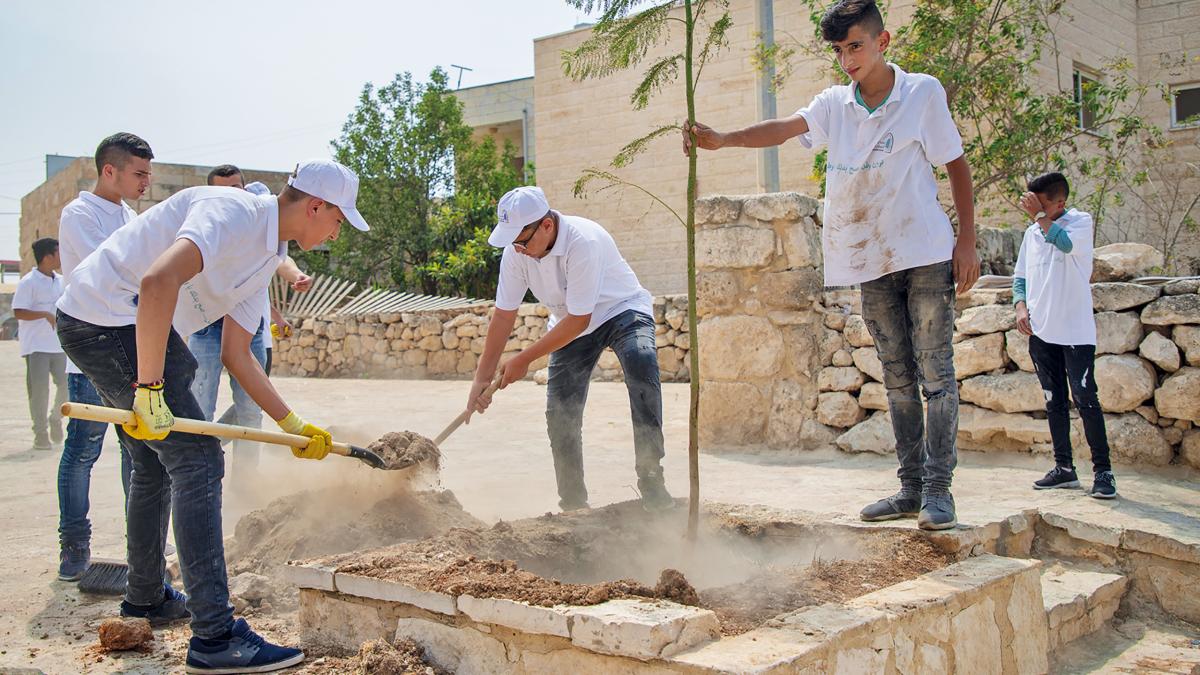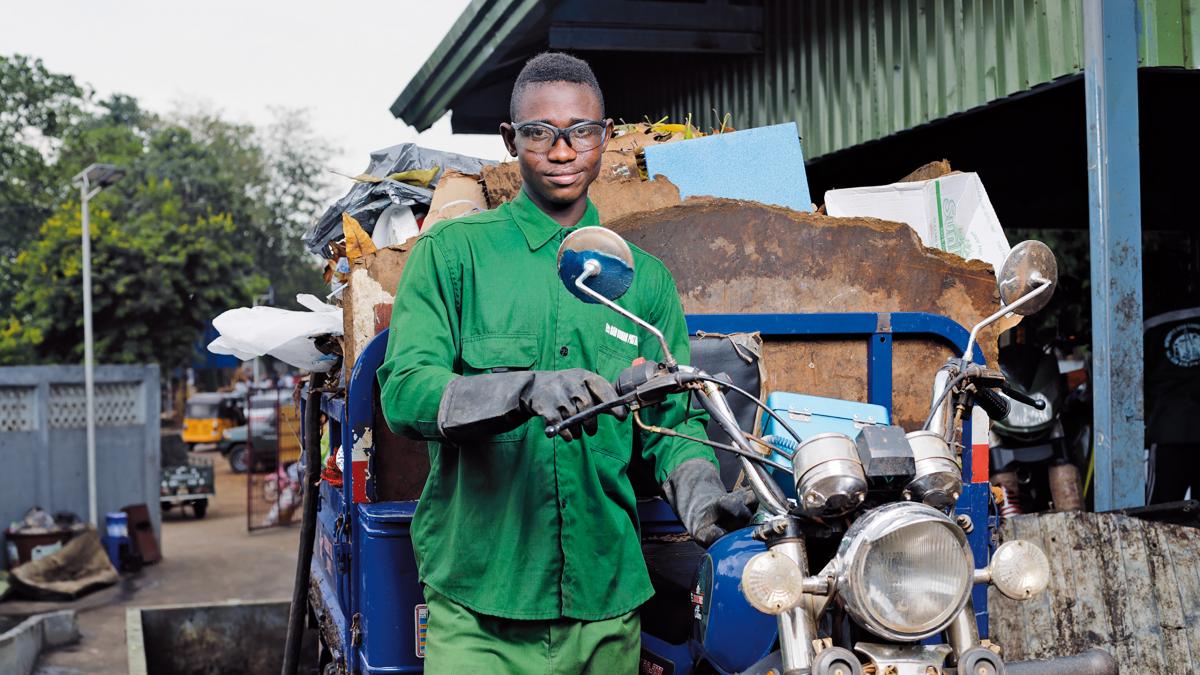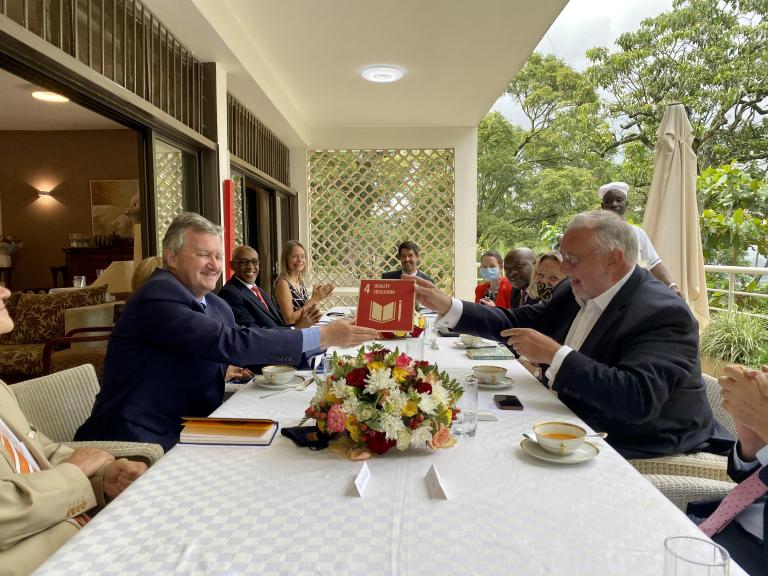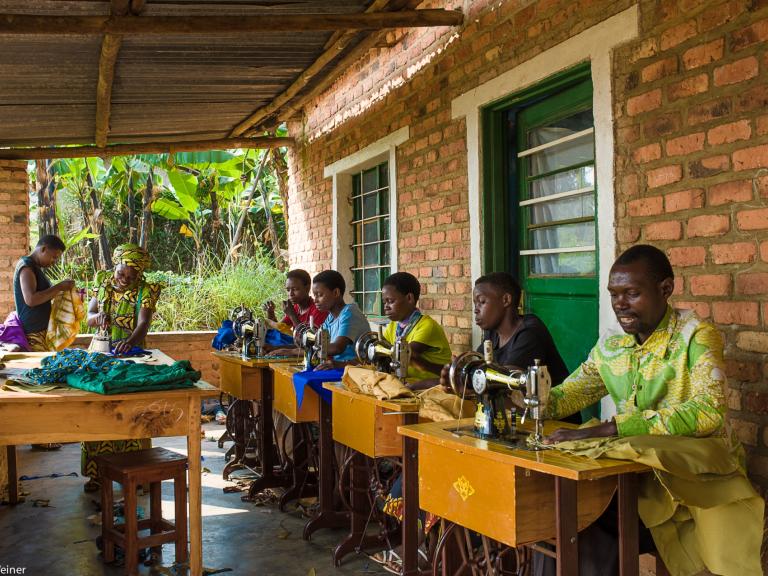-
Last updated on

In the Palestinian Territory Enabel helped revitalise the historic centres of 12 municipalities. © Enabel
SDG11 = Make cities and human settlements inclusive, safe, resilient and sustainable
55% of the world's population currently lives in urban areas, and by 2050 the figure will be 70%. Rapid urbanisation is therefore one of the stand-out trends of the 21st century. This entails huge challenges. How can all these people live in close proximity to each other, peacefully? How can they ensure they have a balanced diet? Can an urban environment also be clean and healthy?
The Sustainable Development Goals (SDGs) anticipated this trend. SDG11 describes in detail the necessary focus points for making cities 'inclusive, safe, resilient and sustainable'. Examples include decent housing, accessible transport, effective waste management, sufficient greenery, etc.

The proliferation of small towns in Africa
The Belgian development agency (Enabel) - which implements the governmental development cooperation - is primarily active in Africa. The African continent has the fastest rate of urbanisation in the world. The population there will double by 2050. Fully two thirds of this population will live in urban areas, especially in small and medium-sized agglomerations. There will be an additional 950 million city dwellers.
'In Africa, in addition to the expansion of cities, we are also seeing a gradual urbanisation of the countryside,' explains Joëlle Piraux, lead urbanisation at Enabel. 'This is due to population growth, high human mobility and a countryside undergoing rapid change. People are also fleeing terrorism and insecurity or the effects of climate change. In the cities they find opportunities for work, infrastructure and services such as education.'
'Rural dwellers move to the small towns first. If these do not meet their expectations, they migrate to the major cities. We especially see this phenomenon in the Sahel (Niger, Mali, Burkina Faso), but also in Central Africa (DR Congo, etc.).'
Cities and the countryside are complementary
Enabel supports these small and medium-sized cities to accommodate the growing, highly diverse population more effectively. It also promotes urban development that is in harmony with the hinterland.
The challenges are huge. Especially in Africa, cities suffer from poor infrastructure, precarious housing, limited public and private sector capacity, high youth unemployment, etc.
Enabel's focus on cities does not mean that it has turned its back on the countryside, on the contrary. Both are highly complementary and this should be exploited more effectively. 'The countryside and peri-urban areas are ideal for producing and processing food. Cities, on the other hand, are more the creative hubs, with both traditional craftsmanship and new technologies, and access to skills and capital. The countryside, in turn, can supply more traditional, environmentally friendly materials.'
A holistic approach to urban economic development in Rwanda
In March 2020 - right in the middle of the corona pandemic - Enabel set up an urbanisation project in 3 medium-sized cities in Rwanda, namely Rubavu, Musanzu and Rwamagana. The latter is a satellite city of the capital Kigali. The main goal was to stimulate sustainable and inclusive economic development and improve infrastructure, using local materials. The entire construction sector is encouraged to develop into a veritable circular economy.
What was striking was that the local community was from the outset closely involved in the project, including through workshops and transect walks. By participating in the process, residents feel that they have a stake in the urban development. As such, the project focuses on the strong sense of community in sub-Saharan Africa. In Rwanda, too, the community is regularly involved, for example to plant trees or clean roads.
The transect walks in the urban zones made it possible to identify the economic potential there. The participants had three perspectives in this regard: that of the community, the private sector and nature. Calls were launched for the projects with the most potential.
Finally 65 companies have been selected for the "local materials" section (earth, stones). They are supported in developing a business plan, while 50% of the machinery is financed. Examples include a press to make bricks. Workshops are also organised about less familiar, promising techniques such as the use of bamboo in construction. In vocational schools, local materials are integrated into the curriculum, and so on.
Enabel prioritises allowing actors from different sectors to work together: the private sector, environment, education... The project is perfectly aligned with Rwandan policy. Rwanda is one of the few countries in sub-Saharan Africa with a robustly developed vision on urbanisation.
A small donor with impact
A small donor like Belgium can have an impact in the development of sustainable and inclusive cities. This is evident from Enabel's 25 years of campaigns, including in Ho Chi Minh City (Vietnam), Kampala (Uganda) and Bujumbura (Burundi). Closely involving the population proved to be a success factor time and again. This is challenging, but very rewarding. That is why Enabel has the goal of creating 'cities that offer everyone a safe and affordable living environment and that involve citizens in the development of their city'.
Within its holistic and multi-sectoral approach, Enabel highlights 5 key points.
Access to quality public services for all
Quality services are essential for a liveable city, also in "informal neighbourhoods". For example, access to drinking water and sewerage, roads, energy, waste management and processing. Enabel provides assistance in this area. In Conakry (Guinea), for example, it improved waste processing as a first step towards a fully-fledged circular economy and cleaner cities.
Enabel promotes local construction jobs and work-based learning opportunities, in order to encourage local communities, and specifically the youth, to participate. It also supports cities in organising a public health service for all, with a particular focus on mental diseases and the health of adolescents.

In Conakry (Guinea) Enabel improved waste processing as a first step towards a fully-fledged circular economy and cleaner cities. © Enabel
Business opportunities and jobs, with additional consideration for youths and women
The talent of young people and women must not be underutilised! After all, if they are given the opportunity to develop their skills and if entrepreneurship is encouraged, the urban economy will be boosted.
The urban environment offers huge potential in this regard. For example, in three urban areas in Guinea, Enabel supports existing SMEs that are active in three sectors: housing and tourism, sustainable cities and the digital economy. Digitisation is a powerful tool for empowering women.

In Guinea, female entrepreneurship is supported. Picture: fruit processing factory. © Enabel
Safe cities based on social cohesion
Enabel aims to help build an inclusive and safe living environment, especially for young people, women and vulnerable groups. 'In the coming years, there will be more of a focus on women-friendly cities. Women need to feel safe in their city. Public spaces must be pleasant, for girls, adolescents and women. Women therefore need to be involved in decision-making,’ concludes Piraux.
One major problem is urban and gender-based violence. In Kisangani (DR Congo), Enabel has developed the Alwaleed health centre into a 'One Stop Centre'. Women can come here not only for medical and psychological monitoring, but also for legal aid and re-integration into society. The plan is to extend the pilot project to other regions.
Culture is also a good bridge builder for restoring social and economic interaction in public spaces. It can even be used to tackle urban violence and involve people more closely in city life. This was Enabel's experience in the Palestinian Territory, for example. There it helped revitalise the historic centres of 12 municipalities. Not only was social cohesion restored and local communities economically revived, the project also reinforced the Palestinian sense of identity.
Resilient cities and agents of change in the face of climate change
Climate and the environment are increasingly in the public eye. Piraux: 'Not only do cities need to adapt to a changing climate, they also need to drastically reduce their activities which contribute to climate disruption. Cities are essential players in this regard! Buildings and installations should not consume too much energy, and residents should be made more aware of their impact on climate disruption.' Enabel is currently developing new projects in the area of Green Municipalities, in both the Palestinian Territory and Mali.
Integrated and participatory city planning and management
All projects ensure that residents are involved in the urban development (see box on Rwanda). This co-creation of policies and instruments leads to more sustainable outcomes. Indeed, the solutions are better adapted to the real needs of the communities, while at the same time the latter feel they have more of a stake. Female leadership is also encouraged.
Digitisation can be an interesting tool to allow residents to participate, for example through the efficient integration of (big) data and citizen-oriented e-services (including population registers). Thanks to digitisation, services can be planned more effectively and made more accessible. Enabel is currently applying such 'e-city management' in Rwanda (smart cities).
'Cities are essential for each of the SDGs', Piraux concludes. 'That's why we need to deepen our "urbanisation strategy" and also apply it in a cross-cutting manner. We are also seeking to engage with non-governmental actors through the Common Strategic Framework (CSF) Sustainable Cities' (see box).
CSF Sustainable Cities
In order to optimise its development cooperation, Belgium aims for maximum synergy between the Belgian non-governmental actors. For example, the "Common Strategic Frameworks" (CSF) bring together all actors (NGOs, universities, trade unions, etc.) to pursue a common goal. Some CSFs bring together all the Belgian players in a given partner country, others focus on a given theme.
The CSF Sustainable Cities strives to bring about sustainable cities in the South. Starting from the existing expertise in Belgium, it has 3 objectives:
- co-creation of the sustainable city by local governments, with close involvement and participation of citizens (Echos Communication, COTA, etc.);
- strengthening institutional capacities (the umbrella organisations of the Belgian municipalities: VVSG (Flanders), UVCW (Wallonia), Brulocalis (Brussels));
- inclusive value chain to nurture sustainable cities (Rikolto, Oxfam Magasins-du-Monde, etc.).
Enabel will also be part of this CSF.
More on People

Team Belgium at work for SDG 4
Team Belgium - the Belgian embassy and the Belgian organisations VVOB and Enabel - was at the helm of the Education Development ...

Equal rights for LGBTIQ people, an ongoing battle
In Belgium, it is a top priority to combat all forms of discrimination, including anti-LGBTI discrimination.

Lifting people out of extreme poverty? It is possible!
To lift the most vulnerable people out of their misery, it takes more than just providing them with resources and broadening the...
